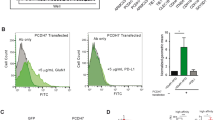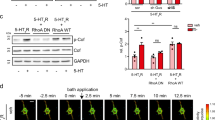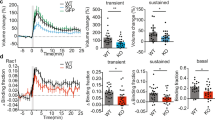Abstract
Dendritic spines are small protrusions emerging from dendrites that receive excitatory input. The process of spine morphogenesis occurs both in the developing brain and during synaptic plasticity. Molecules regulating the cytoskeleton are involved in spine formation and maintenance. Here we show that reverse signaling by the transmembrane ligands for Eph receptors, ephrinBs, is required for correct spine morphogenesis. The molecular mechanism underlying this function of ephrinBs involves the SH2 and SH3 domain–containing adaptor protein Grb4 and the G protein–coupled receptor kinase–interacting protein (GIT) 1. Grb4 binds by its SH2 domain to Tyr392 in the synaptic localization domain of GIT1. Phosphorylation of Tyr392 and the recruitment of GIT1 to synapses are regulated by ephrinB activation. Disruption of this pathway in cultured rat hippocampal neurons impairs spine morphogenesis and synapse formation. We thus show an important role for ephrinB reverse signaling in spine formation and have mapped the downstream pathway involved in this process.
This is a preview of subscription content, access via your institution
Access options
Subscribe to this journal
Receive 12 print issues and online access
$209.00 per year
only $17.42 per issue
Buy this article
- Purchase on Springer Link
- Instant access to full article PDF
Prices may be subject to local taxes which are calculated during checkout








Similar content being viewed by others
References
Nimchinsky, E.A., Sabatini, B.L. & Svoboda, K. Structure and function of dendritic spines. Annu. Rev. Physiol. 64, 313–353 (2002).
Dunaevsky, A., Tashiro, A., Majewska, A., Mason, C. & Yuste, R. Developmental regulation of spine motility in the mammalian central nervous system. Proc. Natl. Acad. Sci. USA 96, 13438–13443 (1999).
Dunaevsky, A., Blazeski, R., Yuste, R. & Mason, C. Spine motility with synaptic contact. Nat. Neurosci. 4, 685–686 (2001).
Trachtenberg, J.T. et al. Long-term in vivo imaging of experience-dependent synaptic plasticity in adult cortex. Nature 420, 788–794 (2002).
Yuste, R. & Bonhoeffer, T. Morphological changes in dendritic spines associated with long-term synaptic plasticity. Annu. Rev. Neurosci. 24, 1071–1089 (2001).
Dalva, M.B. et al. EphB receptors interact with NMDA receptors and regulate excitatory synapse formation. Cell 103, 945–956 (2000).
Grunwald, I.C. et al. Kinase-independent requirement of EphB2 receptors in hippocampal synaptic plasticity. Neuron 32, 1027–1040 (2001).
Henderson, J.T. et al. The receptor tyrosine kinase EphB2 regulates NMDA-dependent synaptic function. Neuron 32, 1041–1056 (2001).
Henkemeyer, M., Itkis, O.S., Ngo, M., Hickmott, P.W. & Ethell, I.M. Multiple EphB receptor tyrosine kinases shape dendritic spines in the hippocampus. J. Cell Biol. 163, 1313–1326 (2003).
Ethell, I.M. et al. EphB/syndecan-2 signaling in dendritic spine morphogenesis. Neuron 31, 1001–1013 (2001).
Penzes, P. et al. Rapid induction of dendritic spine morphogenesis by trans-synaptic ephrinB-EphB receptor activation of the Rho-GEF kalirin. Neuron 37, 263–274 (2003).
Irie, F. & Yamaguchi, Y. EphB receptors regulate dendritic spine development via intersectin, Cdc42 and N-WASP. Nat. Neurosci. 5, 1117–1118 (2002).
Moeller, M.L., Shi, Y., Reichardt, L.F., Ethell, I.M. & Eph, B. Receptors regulate dendritic spine morphogenesis through the recruitment/phosphorylation of focal adhesion kinase and RhoA activation. J. Biol. Chem. 281, 1587–1598 (2006).
Murai, K.K., Nguyen, L.N., Irie, F., Yamaguchi, Y. & Pasquale, E.B. Control of hippocampal dendritic spine morphology through ephrin-A3/EphA4 signaling. Nat. Neurosci. 6, 153–160 (2003).
Contractor, A. et al. Trans-synaptic Eph receptor-ephrin signaling in hippocampal mossy fiber LTP. Science 296, 1864–1869 (2002).
Armstrong, J.N. et al. B-ephrin reverse signaling is required for NMDA-independent long-term potentiation of mossy fibers in the hippocampus. J. Neurosci. 26, 3474–3481 (2006).
Grunwald, I.C. et al. Hippocampal plasticity requires postsynaptic ephrinBs. Nat. Neurosci. 7, 33–40 (2004).
Zhang, H., Webb, D.J., Asmussen, H. & Horwitz, A.F. Synapse formation is regulated by the signaling adaptor GIT1. J. Cell Biol. 161, 131–142 (2003).
Zhang, H., Webb, D.J., Asmussen, H., Niu, S. & Horwitz, A.F.A. GIT1/PIX/Rac/PAK signaling module regulates spine morphogenesis and synapse formation through MLC. J. Neurosci. 25, 3379–3388 (2005).
Cowan, C.A. & Henkemeyer, M. The SH2/SH3 adaptor Grb4 transduces B-ephrin reverse signals. Nature 413, 174–179 (2001).
Zimmer, M., Palmer, A., Kohler, J. & Klein, R. EphB-ephrinB bi-directional endocytosis terminates adhesion allowing contact mediated repulsion. Nat. Cell Biol. 5, 869–878 (2003).
Stein, E. et al. Eph receptors discriminate specific ligand oligomers to determine alternative signaling complexes, attachment, and assembly responses. Genes Dev. 12, 667–678 (1998).
Cho, K.O., Hunt, C.A. & Kennedy, M.B. The rat brain postsynaptic density fraction contains a homolog of the Drosophila discs-large tumor suppressor protein. Neuron 9, 929–942 (1992).
Bauer, A. & Kuster, B. Affinity purification-mass spectrometry. Powerful tools for the characterization of protein complexes. Eur. J. Biochem. 270, 570–578 (2003).
Zhao, Z.S., Manser, E., Loo, T.H. & Lim, L. Coupling of PAK-interacting exchange factor PIX to GIT1 promotes focal complex disassembly. Mol. Cell. Biol. 20, 6354–6363 (2000).
Braverman, L.E. & Quilliam, L.A. Identification of Grb4/Nckβ, a Src homology 2 and 3 domain-containing adapter protein having similar binding and biological properties to Nck. J. Biol. Chem. 274, 5542–5549 (1999).
Palmer, A. et al. EphrinB phosphorylation and reverse signaling: regulation by Src kinases and PTP-BL phosphatase. Mol. Cell 9, 725–737 (2002).
Ethell, I.M. & Yamaguchi, Y. Cell surface heparan sulfate proteoglycan syndecan-2 induces the maturation of dendritic spines in rat hippocampal neurons. J. Cell Biol. 144, 575–586 (1999).
Hoogenraad, C.C., Milstein, A.D., Ethell, I.M., Henkemeyer, M. & Sheng, M. GRIP1 controls dendrite morphogenesis by regulating EphB receptor trafficking. Nat. Neurosci. 8, 906–915 (2005).
Songyang, Z. et al. SH2 domains recognize specific phosphopeptide sequences. Cell 72, 767–778 (1993).
Stein, E., Huynh-Do, U., Lane, A.A., Cerretti, D.P. & Daniel, T.O. Nck recruitment to Eph receptor, EphB1/ELK, couples ligand activation to c-Jun kinase. J. Biol. Chem. 273, 1303–1308 (1998).
Brown, M.C., Cary, L.A., Jamieson, J.S., Cooper, J.A. & Turner, C.E. Src and FAK kinases cooperate to phosphorylate paxillin kinase linker, stimulate its focal adhesion localization, and regulate cell spreading and protrusiveness. Mol. Biol. Cell 16, 4316–4328 (2005).
Haendeler, J. et al. GIT1 mediates Src-dependent activation of phospholipase Cγ by angiotensin II and epidermal growth factor. J. Biol. Chem. 278, 49936–49944 (2003).
Acknowledgements
We would like to thank Cellzome AG, A. Senturk, S. Jordan, M. Zimmer, and E. Martinez for technical help; R.T. Premont (Duke University Medical Center) for GIT1- and GIT2-Flag constructs and antibodies to GIT1, GIT2 and β-PIX; K.S. Erdmann (Ruhr-University) for HeLa-ephrinB1 cells; R. Klein for helpful discussions and A. Yamasaki, I. Kadow and R. Klein for critically reading the manuscript. This work was supported by grants from the Deutsche Forschungsgemeinschaft (AC180/2-1 to A.A.-P.).
Author information
Authors and Affiliations
Contributions
I.S. and S.W. performed the molecular biology and biochemical experiments. C.L.E. conducted the spine assays and dominant negative experiments with the help of I.S. and S.W. A.A.-P. designed and supervised the experiments and wrote the manuscript.
Corresponding author
Ethics declarations
Competing interests
The authors declare no competing financial interests.
Supplementary information
Supplementary Fig. 1
Spine maturation is independently driven by Eph receptor forward and ephrinB reverse signaling. (PDF 715 kb)
Supplementary Fig. 2
GIT proteins interact with Grb4 through the SLD. (PDF 1224 kb)
Supplementary Fig. 3
Grb4 interacts with GIT1 and ephrinB ligands though SH2 and SH3 domains. (PDF 2633 kb)
Rights and permissions
About this article
Cite this article
Segura, I., Essmann, C., Weinges, S. et al. Grb4 and GIT1 transduce ephrinB reverse signals modulating spine morphogenesis and synapse formation. Nat Neurosci 10, 301–310 (2007). https://doi.org/10.1038/nn1858
Received:
Accepted:
Published:
Issue Date:
DOI: https://doi.org/10.1038/nn1858
This article is cited by
-
GIT1 is an untolerized autoantigen involved in immunologic disturbance of spermatogenesis
Histochemistry and Cell Biology (2022)
-
Digenic inheritance of mutations in EPHA2 and SLC26A4 in Pendred syndrome
Nature Communications (2020)
-
Nafamostat Mesilate Improves Neurological Outcome and Axonal Regeneration after Stroke in Rats
Molecular Neurobiology (2017)
-
Mechanisms of ephrin–Eph signalling in development, physiology and disease
Nature Reviews Molecular Cell Biology (2016)
-
Eph/ephrin signaling in the kidney and lower urinary tract
Pediatric Nephrology (2016)



